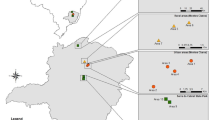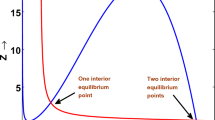Abstract
The vegetation patterns are a characteristic particularity of semiarid zones, which can be the future of modern ecology for its importance. This paper aims to study a diffusive vegetation model for the subject of studying the complex patterns generated by the presence of Turing-Hopf bifurcation. The main focus is on analyzing the effect of the locative internal rivalry between plants and feedback regulation on the pattern formations. The cross-diffusion produced by the positive feedback regulation generates surprising dynamics such as Hopf bifurcation, Turing bifurcation, Turing-Hopf bifurcation, which confirms the imbalance of the distribution of the vegetation in the semi-desert regions. For analyzing the spatiotemporal behavior near the Turing-Hopf bifurcation point, the Amplitude equation restricted at this point is used. Further, by using numerical simulations, the complex dynamics induced by the positive feedback redistribution and inner competition are explored.








Similar content being viewed by others
Data Availability Statement
Data sharing is not applicable to this article as no new data were created or analyzed in this study.
References
H. Amann, Dynamics theory of quasilinear parabolic equation. I. Abstract evolution equation, Nonlinear Anal. 12, 219–250 (1997)
B. Adams, J. Carr, Spatial pattern formation in a model of vegetation-climate feedback. Nonlinearity 16(4), 13–39 (2003)
N. Barbier, P. Couteron, J. Lejoly, V. Deblauwe, O. Lejeune, Self-organized vegetation patterning as a fingerprint of climate and human impact on semiarid ecosystems. J. Ecol. 94(3), 537–547 (2006)
I. Boudjema, S. Djilali, Turing-Hopf bifurcation in Gauss-type model with cross-diffusion and its application. Nonlinear Stud. 25(3), 665–687 (2018)
F. Borgogno, P. D’Odorico, F. Laio, L. Ridolfi, Mathematical models of vegetation pattern formation in ecohydrology. Rev. Geophys. 47, 1–36 (2009)
M.C. Cross, P.C. Hohenberg, Pattern formation outside of equilibrium. Rev. Mod. Phys. 65(3), 851 (1993)
S. Djilali, Impact of prey herd shape on the predator-prey interaction. Chaos Solitons Fract. 120, 139–148 (2019)
S. Djilali, S. Bentout, Spatiotemporal patterns in a diffusive predator-prey model with prey social behavior. Acta Applicandae Mathematicae. 169, 125–143 (2020)
S. Djilali, Pattern formation of a diffusive predator-prey model with herd behavior and nonlocal prey competition. Math. Meth. Appl. Scien. 43(5), 2233–2250 (2020)
K. Gowda, H. Riecke, M. Silber, Transitions between patterned states in vegetation models for semiarid ecosystems. Phys. Rev. E 89, 022701 (2014)
G.Q. Sun, C.H. Wang, L.L. Chang, Y.P. Wu, L. Li, Effects of feedback regulation on vegetation patterns in semi-arid environments. Appl. Math. Model. 61, 200–215 (2018)
R. HillerisLambers, M.G. Rietkerk, F. van den Bosch, H. Prins, H. Kroon, Vegetation pattern formation in semi-arid grazing systems. Ecology 82, 50–61 (2001)
C.A. Klausmeier, Regular and irregular patterns in semiarid vegetation. Science 284, 1826–1828 (1999)
X. Liu, T. Zhang, X. Meng, T. Zhang, Turing-Hopf bifurcations in a predator-prey model with herd behavior, quadratic mortality and prey-taxis. Phys. A 496, 446–460 (2018)
B. Liu, R. Wu, L. Chen, Turing-Hopf bifurcation analysis in a superdiffusive predator-prey model. Chaos 28, 113118 (2018)
N.I. Muskhelishvili, Singular Integral Equations : Boundary Problems of Function Theory and Their Application to Mathematical Physics (Dover Publications, New York, 2013)
A. Pazy, Semi Groups of Liner Operators and Applications to Partial Differential Equations (Springer, Berlin, 2012)
J.A. Sherratt, Pattern solutions of the Klausmeier model for banded vegetation in semiarid environments IV: slowly moving patterns and their stability. SIAM, J. Appl. Math. 73, 330–350 (2013)
J.A. Sherratt, G.J. Lord, Nonlinear dynamics and pattern bifurcations in a model for vegetation stripes in semi-arid environments. Theor. Popul. Biol. 71, 1–11 (2007)
J.A. Sherratt, Pattern solutions of the Klausmeier model for banded vegetation in semi-arid environments II: patterns with the largest possible propagation speeds. Proc. R. Soc. A 467, 3272–3294 (2011)
J.A. Sherratt, Pattern solutions of the Klausmeier model for banded vegetation in semi-arid environments III: the transition between homoclinic solutions. Physica D 242, 30–41 (2013)
S. Djilali, B. Ghanbari, The influence of an infectious disease on a prey-predator model equipped with a fractional-order derivative. Adv. Differ. Equ. (2021). https://doi.org/10.1186/s13662-020-03177-9
F. Souna, A. Lakmeche, S. Djilali, Spatiotemporal patterns in a diffusive predator-prey model with protection zone and predator harvesting. Chaos Solitons Fract. 140, 110180 (2020)
S. Djilali, Spatiotemporal patterns induced by cross-diffusion in predator-prey model with prey herd shape effect. Int. J. Biomath. 13(4), 2050030 (2020). https://doi.org/10.1142/S1793524520500308
S. Bentout, Y. Chen, S. Djilali, Global dynamics of an SEIR model with two age structures and a nonlinear incidence. Acta Appl. Math. (2021). https://doi.org/10.1007/s10440-020-00369-z
S. Bentout, S. Djilali, B. Ghanbari, Backward, Hopf bifurcation in a heroin epidemic model with treat age. Int. J. Modeling Simul. Sci. Comput. (2020). https://doi.org/10.1142/S1793962321500185
G. Sun, L. Li, Z. Zhang, Spatial dynamics of a vegetation model in an arid flat environment. Nonlinear Dyn. 73, 2207–2219 (2013)
F. Souna, S. Djilali, F. Charif, Mathematical analysis of a diffusive predator-prey model with herd behavior and prey escaping. Math. Model. Natural Phenom. (2018). https://doi.org/10.1051/mmnp/2019044
Y. Song, T. Zhang, Y. Peng, Turing-Hopf bifurcation in the reaction-diffusion equations and its applications. Commun. Nonlinear Sci. Numer. Simul. 33, 229–258 (2016)
Y. Song, H. Jiang, Q.X. Liu, Y. Yuan, Spatiotemporal dynamics of the diffusive Mussel-Algae model near Turing-Hopf bifurcation. SIAM J. Appl. Dyn. Syst. 16(4), 2030–2062 (2017)
X. Tang, Y. Song, T. Zhang, Turing-Hopf bifurcation analysis of a predator-prey model with herd behavior and cross-diffusion. Nonlinear Dyn. 86(1), 73–89 (2016)
A.M. Turing, Philos. Trans. R. Soc. Lond. Ser. B Biol. Sci. 237, 37–72 (1952)
C. Valentin, J.M. d’Herbes, J. Poesen, Soil and water components of banded vegetation patterns. Catena 37, 1–24 (1999)
S. van der Stelt, A. Doelman, G.M. Hek, J. Rademacher, Rise and fall of periodic patterns for a generalized Klausmeier-gray-scott model. J. Nonlinear Sci. 23, 39–65 (2012)
J. Von Hardenberg, E. Meron, M. Shachak, Y. Zarmi, Diversity of vegetation patterns and desertification. Phys. Rev. Lett. 87, 198101 (2001)
X. Wang, W. Wang, G. Zhang, Vegetation pattern formation of a water-biomass model. Commun. Nonlinear Sci. Numer. Simulat. 42, 571–584 (2017)
X. Wang, G. Zhang, Vegetation pattern formation in seminal systems due to internal competition reaction between plants. J. Theoret. Biol. 458, 10–14 (2018)
T. Kuniya, T.M. Touaoula, Global stability for a class of functional differential equations with distributed delay and non-monotone bistable nonlinearity. Math. Biosci. Eng. 17(6), 7332–7352 (2020)
T.M. Touaoula, Global dynamics for a class of reaction-diffusion equations with distributed delay and neumann condition. Commun. Pure Appl. Anal. 19(5), 2473–2490 (2018)
M.N. Frioui, T.M. Touaoula, B.E. Ainseba, Global dynamics of an age-structured model with relapse. Discrete Contin. Dyn. Syst. Ser. B 25(6), 2245–2270 (2020)
N. Bessonov, G. Bocharov, T.M. Touaoula, S. Trofimchuk, V. Volpert, Delay reaction-diffusion equation for infection dynamics. Discrete Contin. Dyn. Syst. Ser. B 24(5), 2073–2091 (2019)
T.M. Touaoula, Global stability for a class of functional differential equations (Application to Nicholson’s blowflies and Mackey-Glass models). Discrete Contin. Dyn. Syst. 38(9), 4391–4419 (2018)
T.M. Touaoula, M.N. Frioui, N. Bessonov, V. Volpert, Dynamics of solutions of a reaction-diffusion equation with delayed inhibition. Discrete Contin. Dyn. Syst.-S 13(9), 2425–2442 (2018)
M.N. Frioui, S.E.H. Miri, T.M. Touaoula, Unified Lyapunov functional for an age-structured virus model with very general nonlinear infection response. J. Appl. Math. Comput. 58(5–6), 47–73 (2017)
P. Michel, T.M. Touaoula, Asymptotic behavior for a class of the renewal nonlinear equation with diffusion. Math. Methods Appl. Sci. 36(3), 323–335 (2013)
I. Boudjema, T.M. Touaoula, Global stability of an infection and vaccination age-structured model with general nonlinear incidence. J. Nonlinear Funct. Anal. 2018(33), 1–21 (2018)
M. Banerjee, S. Banerjee, Turing instabilities and spatio-temporal chaos in ratio-dependent Holling-Tanner model. Math. Biosci. 236(1), 64–76 (2012)
M. Banerjee, S. Ghorai, N. Mukherjee, Study of cross-diffusion induced Turing patterns in a ratio-dependent prey-predator model via amplitude equations. Appl. Math. Model. 55, 383–399 (2018)
M. Banerjee, Turing and non-turing patterns in two-dimensional prey-predator models. In: Banerjee S., Rondoni L. (eds) Applications of Chaos and nonlinear dynamics in science and engineering - Vol. 4 (2015) Understanding complex systems. Springer, Cham. https://doi.org/10.1007/978-3-319-17037-4_8
Acknowledgements
S.Bentout, S. Djilali are partially supported by the DGRSDT of Algeria No. C00L03UN130120200004
Author information
Authors and Affiliations
Corresponding author
Appendix
Appendix
Rights and permissions
About this article
Cite this article
Djilali, S., Bentout, S., Ghanbari, B. et al. Spatial patterns in a vegetation model with internal competition and feedback regulation. Eur. Phys. J. Plus 136, 256 (2021). https://doi.org/10.1140/epjp/s13360-021-01251-z
Received:
Accepted:
Published:
DOI: https://doi.org/10.1140/epjp/s13360-021-01251-z




